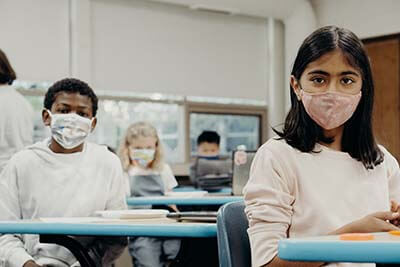September 23, 2021
 from Dr. Bill Hudson, Head of School
from Dr. Bill Hudson, Head of School
It always seems as though the battery on my cell phone is running low. Maybe it’s because I have an older model, or often forget to close apps and plug it in. It is probably the combination of all those factors, although I often blame it on Waze, a crowd-sourced GPS traffic app I use every day that requires a great deal of power to operate.
I think we can all agree that the last 18 months of the pandemic have drained our collective batteries. COVID-19 has been like the Waze app—always open, always draining, hard to close down. Similarly, political discord, social unrest, racial tension, and climate events have also acted like apps that are constantly open and continually draining our reserve. My kids chastise me to close out my apps when I am done using them. (I wish they would do the same with their dirty dishes!) I have decided to follow their advice. Instead of allowing the pandemic to dominate my home screen, it will become just one of many apps on my phone. We must take COVID-19 very seriously, to be sure, but we must also move forward.
That said, our priority is to be on-campus for in-person learning all year. While we are carrying forward many lessons learned during the pandemic, we know how important it is for students to bring their whole selves to school each day. The Minnesota Department of Health (and all available public health guidance) agrees that the benefits of being physically present in school are significant and creating conditions that help safeguard in-person instruction is a priority.
We’ve designed our plan with the MPA mission in mind. Not only are we committed to keeping in-person learning available to students, but we know that preventing on-campus spread may help to reduce the amount of community spread within the Twin Cities. We want to “do right” by doing our part. Layered mitigation remains our shared responsibility: symptom monitoring, prompt reporting of symptoms and exposure, minimizing gatherings and travel, and higher risk activities (particularly for the unvaccinated) in addition to masking, hygiene practices, enhanced ventilation, onsite testing, and the variety of other strategies we have successfully employed during our COVID response.
Thanks to our shared commitment to all of our recommendations and guidelines, we’ve been able to not only have students be in person and learning with their teachers and classmates, but they’re experiencing all that an MPA education has to offer including safe athletics, robust support services, continuity of theatre classes and curriculum, resumed music education, clubs and activities, and a return to many on campus events.
We should celebrate our community’s commitment to vaccinations: 97% of eligible students and 98% of eligible adults have been fully vaccinated. Once vaccines become available for younger ages, which may be much sooner than we thought, we strongly urge parents to seek vaccines for those under 12 as well. When that occurs, we look forward to relaxing a number of protocols that are currently in place.
Anyone who has been paying attention to the news about the impact of COVID 19 on child and adolescent mental health has seen unsettling news. Experts report a startling increase in mental health related emergency room visits, the incidence of eating disorders has increased dramatically, and students themselves are reporting increases in anxiety and depression. The effects seem to be most dramatic in middle school aged children and the oldest and youngest students seem to be impacted in a less substantial way.
But there is good news! Experts in mental health tell us that many of the things we pay attention to at MPA and in our homes are wildly protective. First and foremost is the attention we pay to keeping kids and ourselves safe by following COVID protocols. The structure and safety focus of this program helps kids to know that the adults are “in charge” and that we are paying attention to their safety—an important protective factor for students.
Our community’s focus on keeping students connected to each other and feeling an important part of the MPA community is a protective factor for student’s mental health as well. Opportunities for leadership, focus on inclusion, recognizing small successes, and service to others help students with and without mental health diagnoses. Finally, recent research demonstrates that even students exposed to early childhood adverse experiences (ACES) demonstrate better mental health adjustment when they are connected to two, non-parental, adults. That is what we do best at MPA, focusing on relationships between adults and students in our community.
The pandemic does not have to dominate our lives and drain our reserves. Mindful as we must be, it is but one app among many. While there is still much we can’t do, it is also true that there is much we can do. Thank you for partnering with us to make that happen.
I encourage you to join fellow MPA parents, medical professionals, and members of the MPA COVID Community Advisory Group to learn more about the latest information on the pandemic. Special focus will be given to vaccinations, testing, ways to stay safe during the current surge, and MPA’s mitigation strategies. Panelists include: Dr. Emily Binstadt, Dr. Bryce Binstadt, Dr. Jonathan Faust, and Dr. Courtney Herring. The Q&A session will be moderated by Jennifer Rogers-Petitt, director of development and community engagement and MPA’s COVID-19 lead. This event will be held live on MPA’s Facebook and YouTube pages on Tuesday, September 28 at 7:30 PM. See you there!